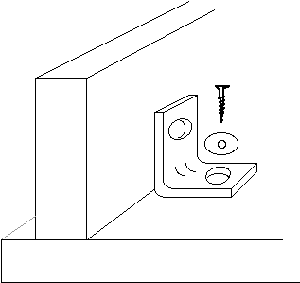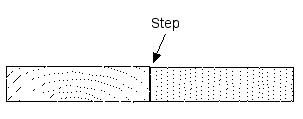
Fastening Table Tops
| Because wood is a very
unstable material it tends to expand and contract due to variations in
the humidy. If a top is fastened securly to the apron and the wood
shrinks any joints may pull apart. To prevent this the top must be held
in place yet be able to move.
Clips in a Dado or Slot Before assembly cut a dado in the apron, or cut slots with a biscuit joiner for clips.
The clips can be either metal or wood, the lip should not protrude to the bottom of the dado, about 1/16" clearance should be left for expansion. Do not use any glue as the clips must float in the dado. Angle Brackets or Blocks Angle brackets or blocks can be used if the screw holes are enlarged to allow the top to move, tighten the screws until they are just snug. Do not glue the block to the top or apron.
Figure 8 Clips This offers a simple way to fasten a top, a rabbet is cut into the inside of the apron, the clips are fastened to the apron and the top.
Gluing Up
When gluing up a top try to select boards with similar grain orientation, the thickness of quartersawn wood contracts more than flatsawn wood causing steps at the joints. If you absolutely have to use the boards on hand arrange them so that the direction of the grain gradually changes.
Quartersawn material is more suitable for table tops, if flatsawn wood is used reversing the direction of the grain helps to prevent the top from warping, however the top may tend to have a wavy appearance. |








